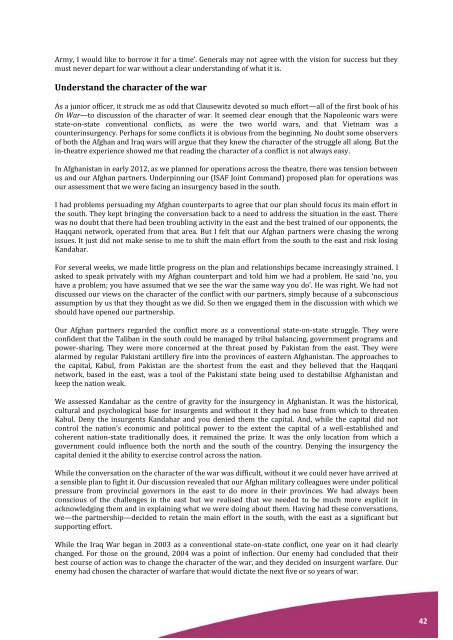Issue No 198 2015
198 2015 Nov_Dec
198 2015 Nov_Dec
Create successful ePaper yourself
Turn your PDF publications into a flip-book with our unique Google optimized e-Paper software.
Army, I would like to borrow it for a time’. Generals may not agree with the vision for success but they<br />
must never depart for war without a clear understanding of what it is.<br />
Understand the character of the war<br />
As a junior officer, it struck me as odd that Clausewitz devoted so much effort—all of the first book of his<br />
On War—to discussion of the character of war. It seemed clear enough that the Napoleonic wars were<br />
state-on-state conventional conflicts, as were the two world wars, and that Vietnam was a<br />
counterinsurgency. Perhaps for some conflicts it is obvious from the beginning. <strong>No</strong> doubt some observers<br />
of both the Afghan and Iraq wars will argue that they knew the character of the struggle all along. But the<br />
in-theatre experience showed me that reading the character of a conflict is not always easy.<br />
In Afghanistan in early 2012, as we planned for operations across the theatre, there was tension between<br />
us and our Afghan partners. Underpinning our (ISAF Joint Command) proposed plan for operations was<br />
our assessment that we were facing an insurgency based in the south.<br />
I had problems persuading my Afghan counterparts to agree that our plan should focus its main effort in<br />
the south. They kept bringing the conversation back to a need to address the situation in the east. There<br />
was no doubt that there had been troubling activity in the east and the best trained of our opponents, the<br />
Haqqani network, operated from that area. But I felt that our Afghan partners were chasing the wrong<br />
issues. It just did not make sense to me to shift the main effort from the south to the east and risk losing<br />
Kandahar.<br />
For several weeks, we made little progress on the plan and relationships became increasingly strained. I<br />
asked to speak privately with my Afghan counterpart and told him we had a problem. He said ‘no, you<br />
have a problem; you have assumed that we see the war the same way you do’. He was right. We had not<br />
discussed our views on the character of the conflict with our partners, simply because of a subconscious<br />
assumption by us that they thought as we did. So then we engaged them in the discussion with which we<br />
should have opened our partnership.<br />
Our Afghan partners regarded the conflict more as a conventional state-on-state struggle. They were<br />
confident that the Taliban in the south could be managed by tribal balancing, government programs and<br />
power-sharing. They were more concerned at the threat posed by Pakistan from the east. They were<br />
alarmed by regular Pakistani artillery fire into the provinces of eastern Afghanistan. The approaches to<br />
the capital, Kabul, from Pakistan are the shortest from the east and they believed that the Haqqani<br />
network, based in the east, was a tool of the Pakistani state being used to destabilise Afghanistan and<br />
keep the nation weak.<br />
We assessed Kandahar as the centre of gravity for the insurgency in Afghanistan. It was the historical,<br />
cultural and psychological base for insurgents and without it they had no base from which to threaten<br />
Kabul. Deny the insurgents Kandahar and you denied them the capital. And, while the capital did not<br />
control the nation’s economic and political power to the extent the capital of a well-established and<br />
coherent nation-state traditionally does, it remained the prize. It was the only location from which a<br />
government could influence both the north and the south of the country. Denying the insurgency the<br />
capital denied it the ability to exercise control across the nation.<br />
While the conversation on the character of the war was difficult, without it we could never have arrived at<br />
a sensible plan to fight it. Our discussion revealed that our Afghan military colleagues were under political<br />
pressure from provincial governors in the east to do more in their provinces. We had always been<br />
conscious of the challenges in the east but we realised that we needed to be much more explicit in<br />
acknowledging them and in explaining what we were doing about them. Having had these conversations,<br />
we—the partnership—decided to retain the main effort in the south, with the east as a significant but<br />
supporting effort.<br />
While the Iraq War began in 2003 as a conventional state-on-state conflict, one year on it had clearly<br />
changed. For those on the ground, 2004 was a point of inflection. Our enemy had concluded that their<br />
best course of action was to change the character of the war, and they decided on insurgent warfare. Our<br />
enemy had chosen the character of warfare that would dictate the next five or so years of war.<br />
42


